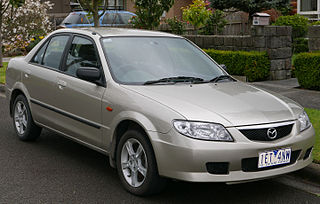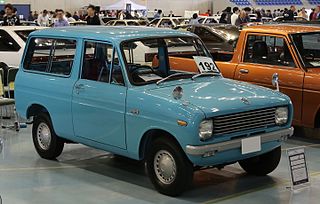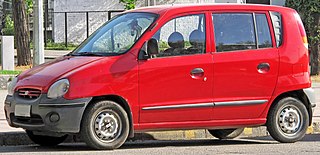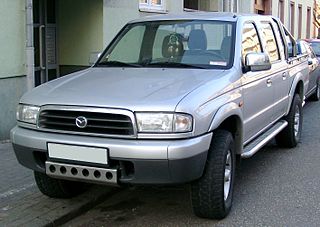
The Ford Laser is a compact car, originally a subcompact car in the first three generations, which was sold by Ford in Asia, Oceania, and parts of South America and Africa. It has generally been available as a sedan or hatchback, although convertible, wagon and pick-up versions have also been available in different markets. The sedan, and briefly station wagon, versions were badged Ford Meteor in Australia between 1982 and 1987. The Ford Meteor name was also used in South Africa.

The Mazda Luce is an executive car that was produced by Mazda in Japan from 1966 until 1991. It was widely exported as the Mazda 929 from 1973 to 1991 as Mazda's largest sedan. Later generations were installed with luxury items and interiors as the Luce became the flagship offering. The Luce was replaced by the Sentia in 1991 which was also exported under the 929 nameplate.

The Mazda Familia, also marketed prominently as the Mazda 323, Mazda Protegé and Mazda Allegro, is a small family car that was manufactured by Mazda between 1963 and 2003. The Familia line was replaced by the Mazda3/Axela for 2004.

The Mazda Bongo, also known as Mazda E-Series, Eunos Cargo, and the Ford Econovan, is a cabover van and pickup truck manufactured by the Japanese automobile manufacturer Mazda since 1966. The Bongo name was also used for the Bongo Friendee, which is not a cabover design.

The Mazda Porter and Porter Cab are a series of small kei trucks that were produced from 1961 to 1989 by Mazda, mainly for sale in the domestic Japanese market. Export versions of the Porter were labelled E360. The Porter was replaced by the Autozam Scrum, a rebadged Suzuki Carry.
After an early flirtation with V-twin engines, Mazda's small cars of the 1960s were powered by OHV straight-2 and straight-4 engines. This family lasted from 1961 until the mid-1970s. Today, Mazda's keicars use Suzuki engines. It was produced at the Hiroshima Plant in Hiroshima, Japan.

Mazda has a long history of building its own diesel engines, with the exception of a few units that were built under license.

The Hyundai Tucson is a compact crossover SUV produced by the South Korean manufacturer Hyundai. It is named after the city of Tucson, Arizona.

The Kia Sportage is a series of automobiles manufactured by the South Korean manufacturer Kia since 1993 through five generations. Initially a compact SUV built on a body-on-frame chassis, the second-generation Sportage transitioned to a car-based platform which placed it into the compact crossover SUV class, and was originally developed alongside the Hyundai Tucson and since the fifth-generation model launched in 2021, in two sizes with different wheelbase lengths for different markets, alongside the Hyundai Santa Fe and the Kia Sorento.

The Mazda Sentia is a mid-size rear wheel drive luxury car that was sold by Mazda in Japan from 1991 to 1999 over two generations. It replaced the Mazda Luce nameplate on the Mazda H platform, and continued the tradition of being Mazda's largest flagship sedan, which had been in production since the late 1960s.

The Mazda Titan is a commercial truck produced by the Japanese automaker Mazda since 1971. From the fourth generation onwards, the vehicle had become a rebadged Isuzu Elf truck.

The Hyundai Atos is a city car that was produced by the South Korean manufacturer Hyundai from 1997 until 2014. It was also marketed under the Atoz, Amica and Santro model names. From 1999, the Atos with a different rear fascia and restyled rear side doors is marketed as the Atos Prime and in South Korea and Indonesia as the Kia Visto. It has been available only with a five-door hatchback body style.

The Škoda Fabia is a series of passenger cars produced by Czech manufacturer Škoda Auto since 1999. It is the successor of the Škoda Felicia, which was discontinued in 2001. The Fabia was available in hatchback, estate and saloon body styles at launch, and from 2007, the second generation was offered in hatchback and estate versions. The third generation Fabia was launched in 2015, and the fourth in 2021.

The Kia Rio is a subcompact car manufactured by Kia from 1999 to 2023. Body styles have included a three and five-door hatchback and four-door sedan, equipped with inline-four gasoline and diesel engines, and front-wheel drive.

The Hyundai Theta is a gasoline four-cylinder automobile engine family. The third all-aluminum engine of Hyundai Motor Company debuted in the fourth-generation Hyundai Sonata sedan, which was unveiled in August 2004 in South Korea. Hyundai Motor Manufacturing Alabama (HMMA) built a Theta II engine shop on the grounds of their Montgomery, Alabama automobile factory.

The Mazda B series is a series of pickup trucks that was manufactured by Mazda. Produced across five generations from 1961 to 2006, the model line began life primarily as a commercial vehicle, slotted above a kei truck in size. Through its production, Mazda used engine displacement to determine model designations; a B1500 was fitted with a 1.5 L engine and a B2600, a 2.6 L engine.
The Kia Concord is a four-door sedan produced by South Korea's Kia from 1987. It is a license-built version of the 1982 Mazda Capella, and all versions accordingly used Mazda four-cylinder engines. The Capital/Concord lineup underwent a series of facelifts, eventually becoming the "New Capital" and "New Concord" in marketing material. Production of the Concord ended in 1995, while the cheaper Capital continued until late 1996. In 1996, Kia replaced the car with the Kia Credos, which they based on the Mazda GE Platform.

The Kia Bongo, also known as the Kia K-Series or Kia Besta, is a cabover pickup truck and van produced by the South Korean automobile manufacturer Kia since 1980.

The Mazda Grand Familia is an automobile which was produced by Mazda in Japan from 1971 to 1978. It was sold as the Mazda 808 in some export markets including Asia, Australia, and New Zealand, and as the Mazda 818 in many others - this was mostly due to Peugeot having trademarked three-digit numbers with a middle zero in many markets. The body style configurations offered were a two-door coupé, a four-door sedan, and a five-door station wagon. The Grand Familia offered only inline four cylinder engines. The largely identical rotary-powered versions were marketed as the Mazda Savanna in Japan, with export markets taking this model as the Mazda RX-3.
The Hyundai A engine also known by its engine code D4CB is a 2.5L diesel 4-cylinder automobile engine produced by Hyundai Motor Group from 2002 up to the present. This is one of the first diesel engines designed and developed solely by Hyundai without any license from any other car manufacturer.



















